The name of this Korean favourite translates as mixed rice, and the recipe is as flexible as that suggests. Though restaurant versions boast a carefully calibrated combination of toppings, according to chef Seoyoung Jung of Seoul’s Bburi Kitchen, “the most beloved type of bibimbap in Korea today … is the homestyle version, which usually consists of leftover banchan [side dishes], a dollop of gochujang and a drizzle of sesame oil”.
Prep 20 min
Cook 40 min
Serves 4
400g short-grain rice, or 4 portions of cooked rice
1 medium carrot
4 tbsp neutral oil
200g fresh shiitake mushrooms, or 6 dried shiitake mushrooms rehydrated in water and then sliced
1 garlic clove, peeled and crushed
1 tbsp soy sauce
4 eggs (optional)
Kimchi, to serve (vegan if necessary)
Toasted sesame oil, to serve
For the spinach
300g spinach (frozen and defrosted is fine)
1 fat garlic clove, peeled and crushed
1 tsp toasted sesame oil
1 tsp soy sauce
1 tsp toasted sesame seeds
For the beansprouts
100g beansprouts
½ fat garlic clove, peeled and crushed
1 spring onion, trimmed and thinly sliced diagonally
1 tsp toasted sesame oil
½ tsp toasted sesame seeds
Salt
For the sauce
4 tbsp gochujang chilli paste
1 tbsp sesame oil
½ tsp sugar (optional)
1 garlic clove, peeled and crushed
1 Meaty, vegetarian or vegan?
One of the beauties of this dish is that it can be prepared in advance up to the end of step 7, and you can leave out or substitute toppings as you wish. Bibimbap is often made with beef tartare or bulgogi (grilled marinated sliced beef), but the simplest versions, as here, are vegetarian. Leave out the egg, or replace it with tofu, to make it vegan.
2 A note on the rice
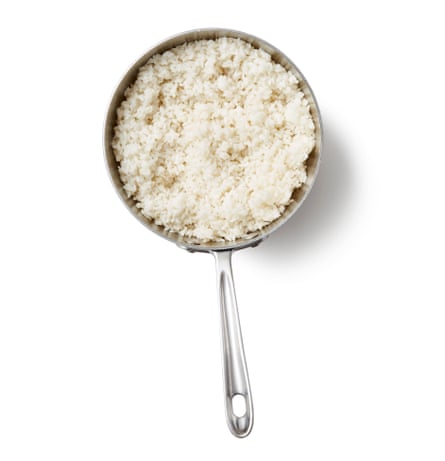
If you’re cooking the rice from scratch (though you can buy cooked short-grain rice from specialist Korean food stores), and if you have the time, put it in a sieve and rinse with cold water, rubbing the grains together until the water runs clear. Leave to drain and dry for 20 minutes while you get on with the vegetables. (Alternatively start at step 4)
3 If cooking the rice …
Put the rinsed rice in a saucepan with 275ml cold water and leave it to sit for five minutes. Cover and bring to a boil, then turn the heat right down and cook very gently for 15 minutes. Turn off the heat and leave to sit for 10 minutes, then fluff up gently with a flat spatula.
4 Prepare the spinach …

While the rice is drying and cooking, blanch the spinach, if using fresh, in boiling water for a minute, then scoop out with a slotted spoon, rinse under cold water and squeeze out as much excess liquid as you can; if using defrosted spinach, simply squeeze it dry. Roughly chop the spinach, mix it with the crushed garlic, oil and soy sauce, then season to taste and sprinkle with sesame seeds, and set aside.
5 … and the beansprouts, carrot and mushrooms
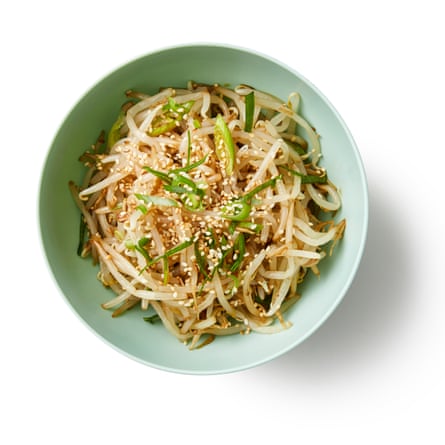
In the same water as the spinach, boil the beansprouts for four or five minutes, until tender, then drain and refresh under cold water. Mix with the garlic, spring onions, sesame oil and seeds, and a good pinch of salt, then set aside with the spinach. Peel and cut the carrot into matchsticks and tear the mushrooms into bite-size pieces.
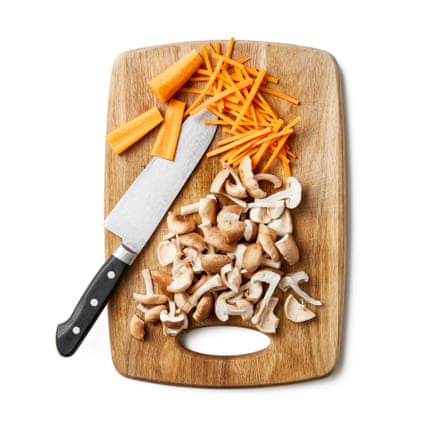
6 Fry the carrot and mushrooms
Put a tablespoon of oil in a frying pan on a medium heat, add the carrots and a pinch of salt, and stir-fry for three to five minutes, until softened.

Tip out into a small bowl, add another tablespoon of oil to the pan and repeat with the mushrooms.

After about two minutes, stir in the crushed garlic and soy sauce, saute briefly, then scoop out into another small bowl (if you’re planning to serve the bibimbap immediately, don’t bother to wash out the pan).
7 Make the sauce
In a small bowl, mix all the ingredients for the gochujang sauce with a tablespoon of cold water; depending on how long your red pepper paste has been open, you may need to add a little more water to achieve the desired drizzling consistency, because it tends to dry out over time.
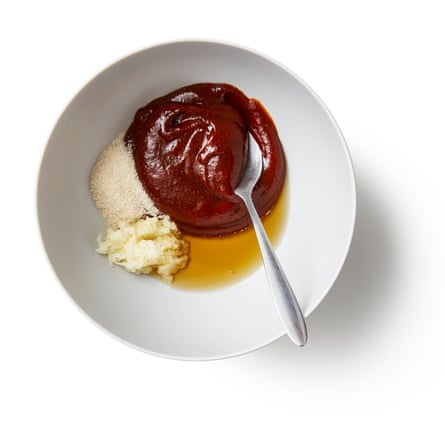
Taste and adjust the seasoning as necessary. (Alternatively, just use straight gochujang, if you prefer.)
8 Fry the eggs
When you’re ready to serve, turn on the oven to low and put four heatproof bowls in there to warm up. Put the remaining two tablespoons of oil in a frying pan on a medium-high heat (use the same one you used for the carrots and mushrooms) and fry the eggs, if using, to your liking, then set these aside.
9 Assembly
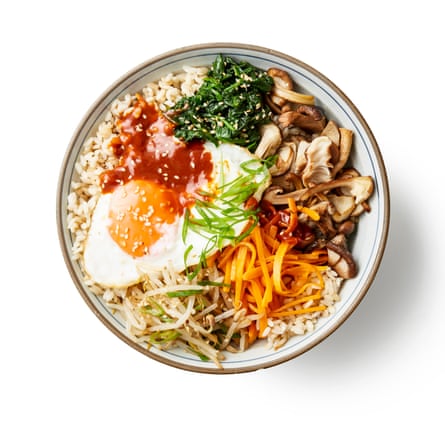
Brush the pan with sesame oil, turn up the heat to high, then add the rice and leave it to sit for a couple of minutes, until it starts to toast and crisp on the bottom. Divide the rice between the warmed bowls and top with the spinach, beansprouts, carrots, mushrooms, kimchi, sauce, eggs and a drizzle of sesame oil.
Take to the table and encourage your guests to mix everything together gently before eating.
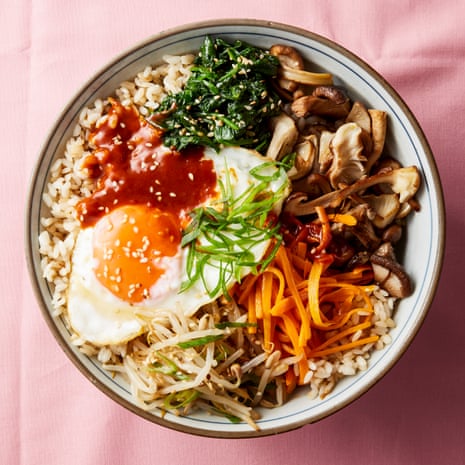
Comments (…)
Sign in or create your Guardian account to join the discussion